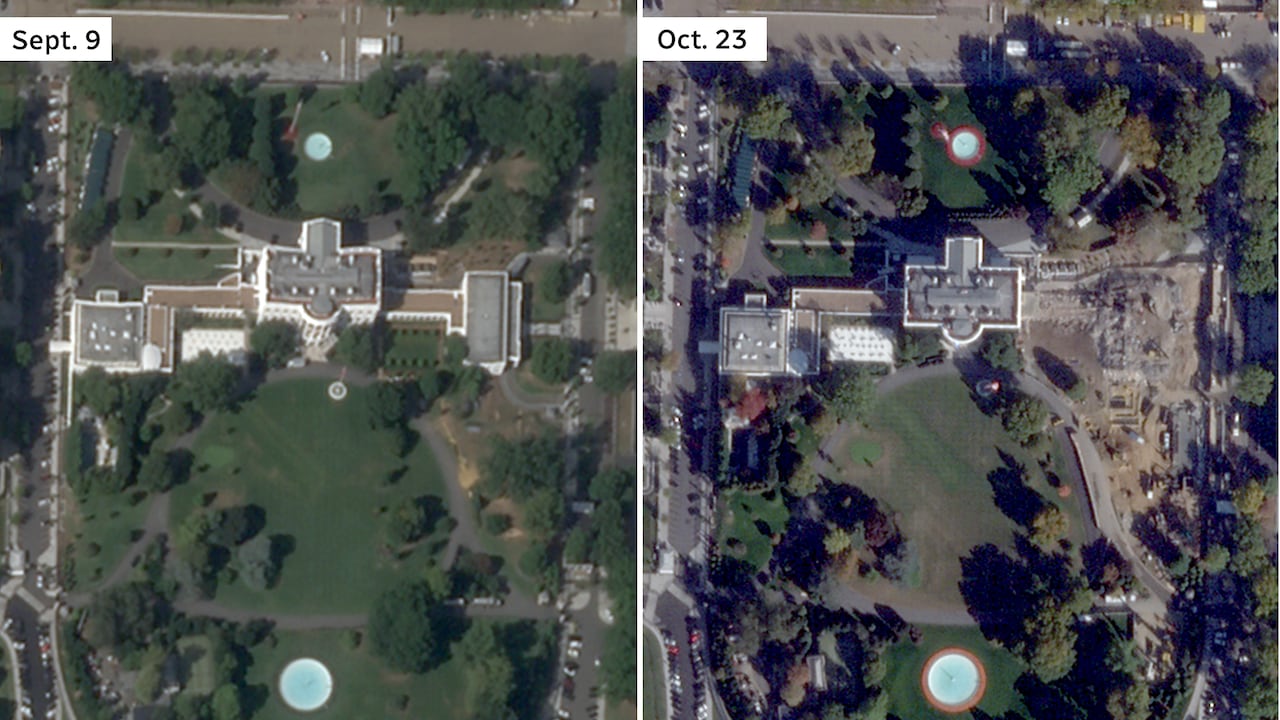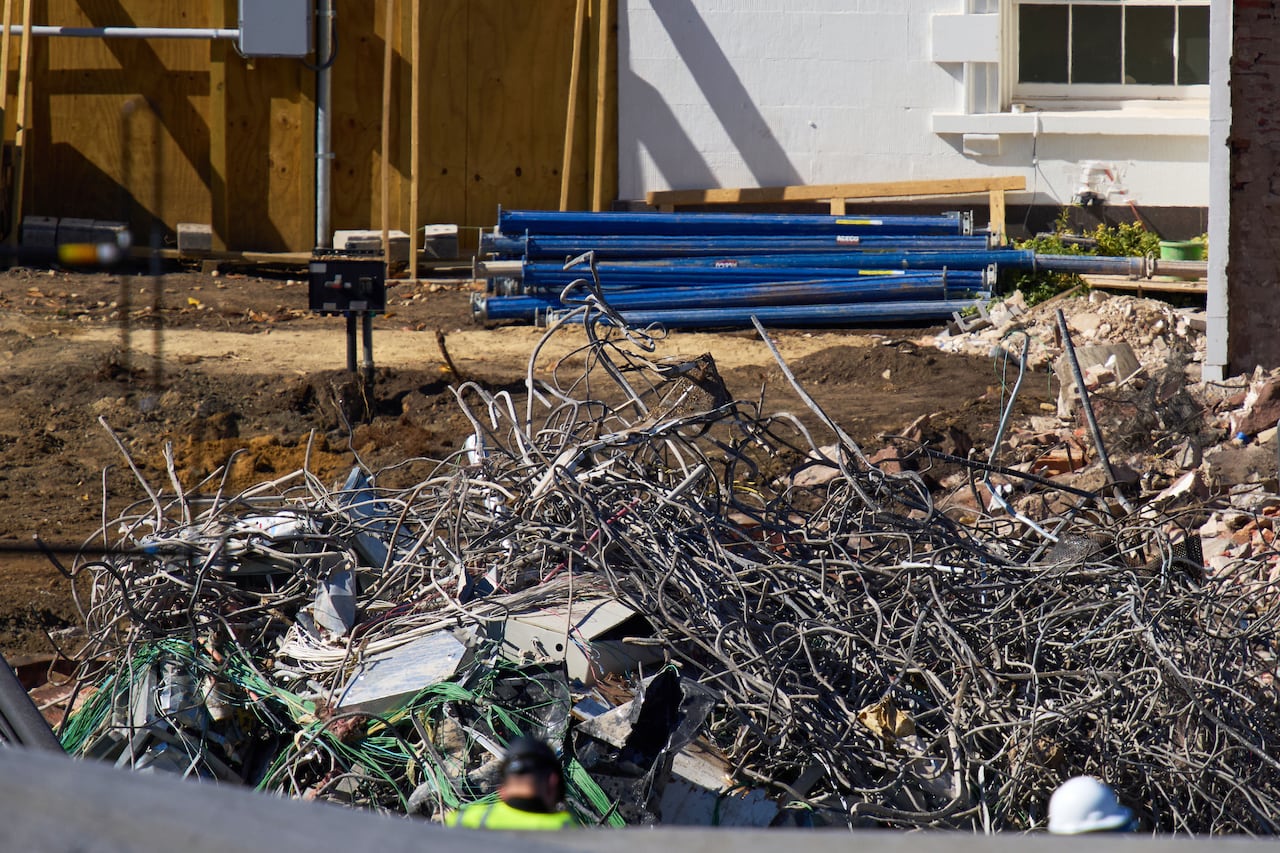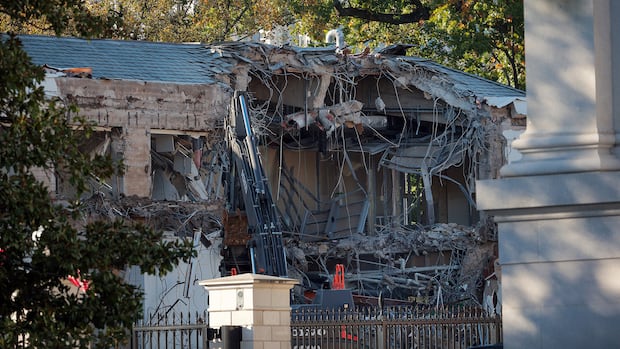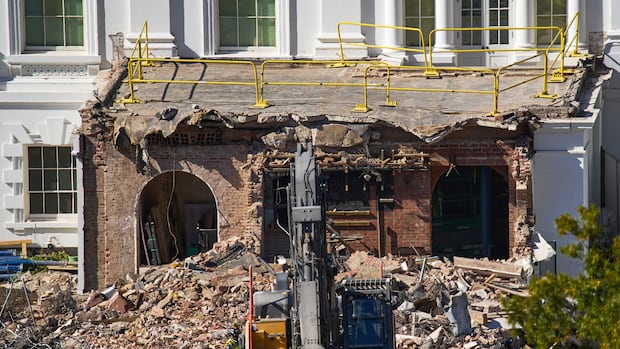The Democrats are promising to investigate how President Donald Trump and his administration moved ahead with a White House demolition that has proceeded at a rapid pace, as Americans have posted “RIP East Wing 1902-2025” on social media platforms.
The East Wing was essentially fully gone by Thursday, after construction began three days earlier.
The wing, first built over a century ago during president Teddy Roosevelt’s administration, has served as a base for the spouse of the president, and it is where visitors entered for public tours or to attend events like state dinners.
Meanwhile, the White House released a list of donors on Thursday who are contributing money to the building of a future ballroom on the property, a project the administration insists won’t come at the expense of taxpayers. But White House critics say soliciting money from the private sector brings its own set of problems.
 Satellite photos show the White House grounds several weeks ago, left, and this week. (Planet Labs PBC/CBC News)
Satellite photos show the White House grounds several weeks ago, left, and this week. (Planet Labs PBC/CBC News)
“This is part of what Donald Trump has been doing since Day 1 of his presidency, running the largest pay-to-play scheme in the history of the country, and probably soliciting donations from from people who’ve got business before the United States government,” Democratic House leader Hakeem Jeffries said this week, in an interview with MSNBC.
Jeffries promised the Democrats will demand accountability and investigate what led to the demolition, but are limited as to what they can achieve in the Republican-led House, at least until next year’s midterms.
Tech giants head list of donors
While donation amounts are not known at this time, the White House released a list of contributors on Thursday that included tech giants Amazon, Apple, Meta and Alphabet, as well as foundations and individuals who are longtime allies of Trump.
According to a CBS News report, donors have the option to put forth a lump sum or spread their contributions in three installments by 2027.
“Lockheed Martin is grateful for the opportunity to help bring the President’s vision to reality and make this addition to the People’s House, a powerful symbol of the American ideals we work to defend every day,” a spokesperson for the defence contractor said in a statement.
Refrigeration and ventilation corporation Carrier said earlier this week it was “honoured to provide the new iconic ballroom at the White House with a world-class, energy-efficient HVAC system.”
The donations come amid a second-term Trump presidency in which his administration has pressured law firms, media companies and colleges and universities for concessions, apologies or specific action on preferred policy items. The administration has also taken a stake in more than one company, in a departure from traditional conservative Republican orthodoxy.
It’s unclear how many contracts or transactions these companies currently have with the federal government, but Syracuse.com reported that the semiconductor company Micron Technology, one of the ballroom donors, was already set to get federal tax breaks and grants for a new manufacturing complex in upstate New York.
Shifting claims and figures
The 90,000 square-foot ballroom would be the biggest structural change to the Executive Mansion — which is about half the size of the proposed ballroom — in nearly 80 years.
While addressing the ballroom project in July, both Trump and White House press secretary Karoline Leavitt said it would not require a teardown.
In addition, the price tag has increased in Trump’s various statements in recent months, from $200 million US to $250 million to $300 million, as the ballroom has evolved from a stated 650-seat facility in July to a capacity of nearly 1,000 now.
Trump has been circumspect about the prospect of putting up his own money.
“I won’t be able to tell you until I finish, but I’ll donate whatever is needed,” he said on Thursday.
How this project appears to differ
East Wing renovations during Harry Truman’s administration appear to be the most expensive until now, the equivalent of $60 million in today’s dollars. But much of the work was necessary, the White House Historical Society has said, because engineers discovered the White House “was in danger of collapse.”
Nearly every president since has overseen some modest to moderate-sized renovations to the exterior or interior work, out of a perceived need or preference, with Ronald Reagan famously removing the roof solar panels installed during predecessor Jimmy Carter’s term.
Trump isn’t the first to solicit private money for a build and avoid using taxpayer money — Gerald Ford did so for an outdoor pool, while the Obamas did so for redecorating purposes.
 Wires, rebar and debris are seen as work continues on a largely demolished part of the East Wing of the White House on Thursday. (Jacquelyn Martin/The Associated Press)
Wires, rebar and debris are seen as work continues on a largely demolished part of the East Wing of the White House on Thursday. (Jacquelyn Martin/The Associated Press)
Democratic Sen. Richard Blumenthal took issue with Republicans comparing the ballroom to past renovation projects.
“[Past presidents] filled in the pool. They may have taken out a bowling alley. They haven’t destroyed an entire wing of the White House in a way that is irreversible,” he said.
House Democrats on Thursday wrote to the White House demanding answers to a number of questions and citing the “strong historical precedent of Congress providing funding for general upkeep and maintenance of the White House.” They also asked why the administration did not hold legally required public consultations, including through two commissions that have signed off on previous alterations, the National Capital Planning Commission and the Commission of Fine Arts.
Will Scharf, the chair of the National Planning Commission, said in September the agency he leads does not have jurisdiction over demolition or site preparation work for buildings on federal property.
“What we deal with is essentially construction, vertical build,” said Scharf, who is also the White House staff secretary.
Bryan Green, who served as an NCPC commissioner under Democratic president Joe Biden, questioned that explanation.
“Demolition really cannot be separated from the new construction that follows,” Green told Reuters. “These are linked.”
Green and others have also pointed out that the first Trump administration followed the proper consultative process with the two aforementioned commissions when adding a tennis pavilion.
It appears to be another case where the second Trump administration has taken traditions that aren’t quite ironclad and ignored them.
Sarah Bronin, professor of law at George Washington University and also an architect, told Reuters that while the demolition is a unilateral action that is “virtually unprecedented,” she added that “it’s pretty clear that Congress hasn’t written strong enough rules to curb activities like this that might take place.”
Despite the apparent differences with past precedent and the evolving cost figures, Leavitt said Thursday that “with any construction project, there are changes over time as you assess what the project is going to look like,” while asserting that “the president has been incredibly transparent.”
But the White House has provided little information on how the demolition affected the President’s Emergency Operations Center, a bunker the commander-in-chief can use in emergencies, located under the East Wing.
Little pushback from congressional Republicans
House Speaker Mike Johnson said on Thursday “the ballroom is going to be glorious.”
“By the way, hey Democrats, if you win the White House back, you get to use it, too,” he added.
Johnson and Republican Sen. Markwayne Mullin stressed that the project is being paid for with private money, with Mullin also leaning into Trump’s career as a real estate baron.
WATCH | New White House ballroom will be larger than a football field:
White House’s entire East Wing being demolished for Trump’s ballroom
U.S. President Donald Trump now plans to demolish the entire East Wing of the White House after saying previously that the current building would not be ‘interfered with’ during the now $300-million US renovation. Administration sources say the demolition will be finished by the weekend.
Republican senators Thom Tillis and Lisa Murkowski have expressed concern this week about the optics. The government has been shut down for more than three weeks — multiple polls suggest that Americans blame Republicans more than Democrats for the impasse — and next week, millions of lower-income Americans could lose access to needed food assistance benefits.
“We’re talking about building a ballroom when we’re trying to get the economy squared away. The timing’s bad,” said Sen. Tillis.
The public reacts
In D.C., tourists have flocked to catch a glimpse of the bulldozers and debris.
“It’s his house … he’s spending his money and not my taxpayer money. It’s OK with me,” Erich Habelt, of California, told the Associated Press. “And as with any old house, things need to be renovated.”
Jonathan Fineberg, a 79-year-old from Philadelphia, offered a different take on Thursday while speaking to Reuters.
“This country is full of homeless people with nothing to eat, and this moron is spending this kind of money on this?”

